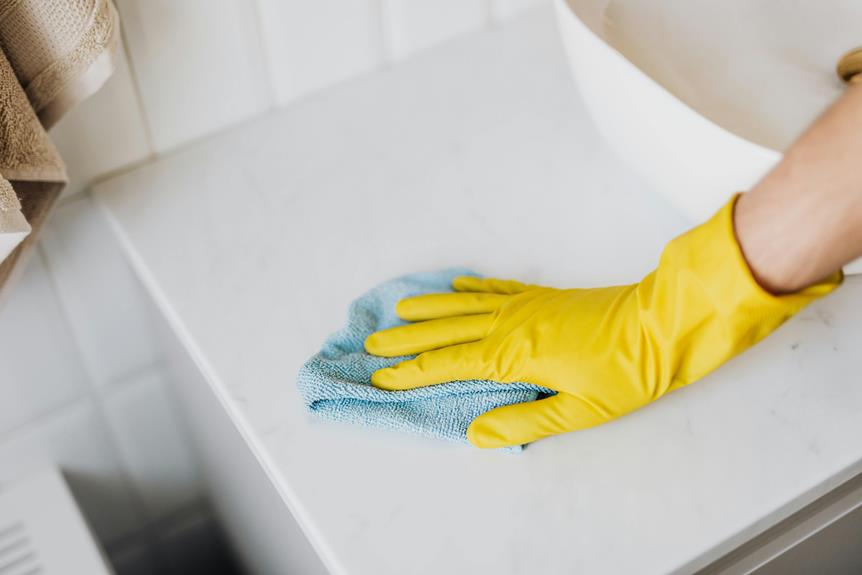When you're faced with the challenge of removing starch from your fabrics, it's essential to approach the task methodically to avoid damage. Start by testing a small area to ensure the treatment doesn't affect the fabric's color or texture. Soaking in warm water and using a gentle detergent can work wonders, but knowing how long to soak is crucial. After rinsing, you might wonder how to tackle those stubborn remnants or prevent future buildup. The following methods could make all the difference in keeping your fabrics looking their best.
Table of Contents
Key Takeaways
- Test fabric compatibility by applying starch remover on a hidden area to check for any adverse effects before full treatment.
- Soak fabrics in warm water mixed with gentle detergent or vinegar for 30 minutes to 2 hours, depending on starch buildup severity.
- Rinse fabrics in cool water, agitating gently to lift starch particles, and soak for an additional 10-15 minutes if needed.
- Wash sorted fabrics using appropriate cycles, pre-treat stains, and rinse thoroughly to eliminate any remaining starch and detergent residues.
Understanding Fabric Starch
Fabric starch is a common laundry product that gives clothes a crisp finish, but it can be tricky to remove once it builds up. You might love the polished look starch provides, especially for dress shirts and table linens, but over time, it can create a stiff, unyielding texture that detracts from your fabric's natural feel.
Starch comes in various forms, including liquid sprays and powder, each designed to bond with the fibers of your fabric. When you use starch, it coats the fibers, giving them structure and reducing wrinkles. However, repeated applications without proper cleaning can lead to residue accumulation.
This buildup not only makes your fabrics feel rough but can also attract dirt and dust, leading to an overall dingy appearance. It's essential to understand that while starch enhances the appearance of your garments, it can also complicate your laundry routine.
If you don't address the starch buildup, it may require more effort to restore your fabrics to their original softness. Recognizing the effects of fabric starch can help you make informed decisions about your laundry practices.
Preparing for Starch Removal
Before you start removing starch, you'll need to gather some essential supplies like water, a spray bottle, and a clean cloth.
It's also important to test your fabric's compatibility with the removal method you choose to avoid any damage.
With everything ready, you can confidently tackle the starch removal process.
Gather Necessary Supplies
To tackle starch removal effectively, you'll need a few essential supplies on hand.
Start with a good-quality fabric-safe starch remover or a DIY solution, like a mix of vinegar and water. This will help break down the starch without damaging your fabric.
Next, grab a clean spray bottle for easy application. This makes it simple to target the areas that need treatment.
You'll also want a soft cloth or sponge to gently blot the fabric after applying the remover. Avoid using anything too abrasive, as it could harm the fibers.
Don't forget a bowl or sink for rinsing the fabric after treatment. Water is crucial to thoroughly remove the starch. You might also find it useful to have a clean towel nearby to absorb excess moisture.
Lastly, have an iron and an ironing board ready if you plan to press the fabric after cleaning. Ironing can help restore the fabric's original texture and appearance.
With these supplies gathered, you're all set to start your starch removal process efficiently and safely!
Test Fabric Compatibility
Testing the fabric's compatibility with your chosen starch remover is a smart step before applying it to the entire area. You don't want to risk damaging your fabric, so start by selecting a small, inconspicuous spot. This could be a hem, seam, or an area that's less visible.
Apply a small amount of the starch remover to this test area using a cotton swab or a soft cloth. Wait a few minutes to observe how the fabric reacts. Check for any discoloration, fading, or changes in texture. If the fabric looks good and holds up well after testing, you're in the clear to proceed with the removal process on the larger area.
If you notice any adverse effects, it's best to try a different starch remover or method that's more suitable for your fabric type. Always refer to care labels and manufacturer instructions for guidance, as not all fabrics respond the same way to starch removal techniques.
Choose Removal Method
Selecting the right removal method is crucial for effectively getting rid of starch without harming your fabric.
First, consider the type of fabric you're dealing with. For delicate materials like silk or lace, a gentler approach is essential. You might want to use a mild solution of warm water and a little dish soap, applying it carefully with a soft cloth.
For sturdier fabrics like cotton or linen, you can be a bit more aggressive. Soaking the fabric in warm water mixed with vinegar can help break down the starch effectively. If the starch buildup is significant, you may opt for commercial starch removers, but always check the label to ensure compatibility with your fabric type.
Don't forget to test any method on a small, inconspicuous area first. This way, you can confirm that your chosen removal method won't cause discoloration or damage.
Once you've determined the best approach, gather your supplies and get ready to tackle that stubborn starch. Remember, patience is key, and following these steps will help you restore your fabrics to their original state.
Method 1: Soaking Fabrics
When it comes to soaking fabrics, you need to choose the right solution for effective starch removal.
Pay attention to the soaking duration guidelines to avoid damaging the material.
Choosing the Right Solution
To effectively remove starch from fabrics, soaking them in a suitable solution can break down the buildup and restore their softness. The key is to choose the right solution that'll work best for your specific fabric type.
For most cotton and linen items, a mixture of warm water and a gentle detergent will do the trick. Make sure the detergent is free from bleach and harsh chemicals to avoid damaging the fibers.
If you're dealing with delicate fabrics like silk or wool, consider using a mixture of cool water and a specialized fabric cleaner designed for those materials. This gentler approach helps maintain the integrity of the fabric while still addressing the starch issue.
For an eco-friendly alternative, you might try a solution of white vinegar and water. Vinegar can effectively cut through starch while being safe for most fabrics. However, always test any solution on a hidden area first to ensure it won't cause discoloration.
Soaking Duration Guidelines
Soak your fabrics for at least 30 minutes to effectively loosen the starch buildup. This duration allows the solution to penetrate the fibers and break down the starch, making it easier to remove. Depending on the level of starch, you might want to adjust the soaking time.
Here are some guidelines to keep in mind:
- Light Starch Buildup: If your fabric has only a light layer of starch, 30 minutes should suffice. Check the fabric periodically to gauge progress.
- Moderate Starch Buildup: For moderate buildup, extend the soaking time to about 1 hour. This extra time will help ensure the solution works through the fibers more thoroughly.
- Heavy Starch Buildup: If the fabric is heavily starched, consider soaking it for up to 2 hours. Make sure to monitor the fabric to prevent any potential damage, especially if it's delicate.
After soaking, you'll find that the starch is much easier to remove. Keep these guidelines in mind for the best results, ensuring your fabrics come out clean and starch-free.
Rinsing and Drying Tips
After soaking your fabrics, rinsing them properly is key to ensuring all the loosened starch is removed effectively.
Begin by filling a basin or tub with cool water. Gently agitate the water to create movement, which helps lift the starch from the fibers.
Submerge your fabrics completely, allowing them to soak for about 10-15 minutes. This additional soaking gives the starch more time to dissolve. After soaking, take the fabrics out and gently squeeze out the excess water. Avoid wringing, as this can damage the fibers.
Next, rinse each fabric under cool running water. Start at one end and let the water flow through to the other, ensuring that the starch is washed away. If you see any residue, repeat the rinsing process.
Once rinsed, gently squeeze out as much water as possible before drying. Lay the fabrics flat on a clean towel to absorb more moisture, or hang them up to air dry. Avoid direct sunlight, which can fade colors.
Method 2: Washing Techniques
Washing your fabric with hot water can effectively help remove stubborn starch residues. This technique works best for cotton and linen fabrics. Before you start, make sure to check the care label for any temperature restrictions.
Here's how to do it:
- Sort Your Fabrics: Separate items based on color and fabric type. Washing similar fabrics together prevents damage and bleeding colors.
- Pre-Treat Stains: If you notice any stains, apply a small amount of liquid detergent directly to the affected areas. Gently rub it in with your fingers and let it sit for about 10 minutes.
- Choose the Right Cycle: Set your washing machine to a hot water cycle, adjusting the spin speed based on the fabric's thickness. For lighter items, a delicate cycle works better, while heavier fabrics can handle a normal cycle.
After washing, rinse the fabric thoroughly to ensure all detergent and starch residues are removed.
If needed, you can repeat this washing process until you achieve the desired results. This method not only cleans your fabric but also leaves it feeling fresh and soft!
Method 3: Steam Treatment
Using steam treatment is an effective way to loosen and remove starch from fabrics without the need for washing. This method utilizes the heat and moisture of steam to break down starch particles, making it easier for them to release from the fabric fibers. Here's how to do it:
- Prepare your steamer: Fill the water reservoir and let it heat up.
- Hang the fabric: Place your fabric on a hanger or lay it flat on an ironing board.
- Apply steam: Hold the steamer a few inches away from the fabric and move it in a sweeping motion over the starchy areas. Be careful not to saturate the fabric.
| Step | Description |
|---|---|
| 1. Prepare Steamer | Fill with water and heat it up. |
| 2. Hang Fabric | Use a hanger or lay it flat on a surface. |
| 3. Apply Steam | Sweep the steam over the fabric gently. |
| 4. Let Dry | Allow the fabric to dry completely. |
| 5. Check Results | Inspect for remaining starch. |
This method is quick and convenient, offering a safe alternative to washing when you want to refresh your fabrics!
Preventing Starch Buildup
To keep your fabrics looking fresh and avoid starch buildup, it's important to implement a few simple practices during ironing and laundry. By following these tips, you can maintain the integrity of your fabrics while minimizing the need for frequent starch removal.
- Use Starch Sparingly: When applying starch, less is often more. Start with a light mist and gradually increase if needed. This way, you'll reduce the risk of excess buildup on your clothes.
- Wash Regularly: Make it a habit to wash your starched fabrics more frequently. Regular washing helps remove any residue that may accumulate over time, keeping your items looking crisp and clean.
- Opt for Alternatives: Consider using fabric finish sprays that are starch-free. These alternatives can provide a similar crispness without the risk of buildup, allowing you to enjoy fresh-looking garments without the hassle of starch.
Frequently Asked Questions
Can I Use Vinegar Instead of Commercial Starch Removers?
You can definitely use vinegar instead of commercial starch removers. It's a natural option that can help break down the starch, leaving your fabrics fresh and clean without harsh chemicals. Just dilute it with water first!
Is Starch Removal Safe for All Fabric Types?
Starch removal isn't safe for all fabric types. Delicate fabrics like silk and lace can get damaged, while sturdier materials usually handle it better. Always check care labels and test a small area first.
How Often Should I Remove Starch From My Fabrics?
You should remove starch from your fabrics whenever they feel stiff or have a dull appearance. Regular maintenance every few washes helps keep them looking fresh and prevents buildup that can damage the fabric over time.
Will Removing Starch Affect the Fabric's Color?
Removing starch typically won't affect your fabric's color. However, if the fabric is delicate or dyed, it's wise to test a hidden area first. This way, you can ensure the color remains vibrant.
Can I Remove Starch From Upholstery Fabrics?
Yes, you can remove starch from upholstery fabrics. Start by testing a hidden area with a gentle solution. Blot the stained area, rinse, and repeat until the starch is gone, ensuring you don't damage the fabric.
- How to Tell if Fabric Is Woven or Nonwoven - July 10, 2025
- The Complete Guide to Nonwoven Materials - July 10, 2025
- What Is a Nonwoven Textile? a Broad Definition - July 9, 2025







